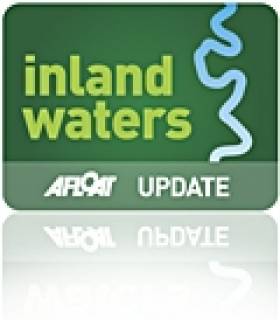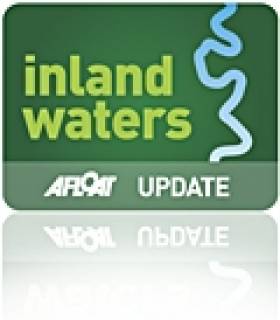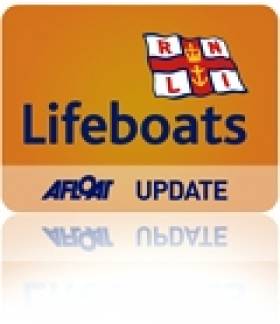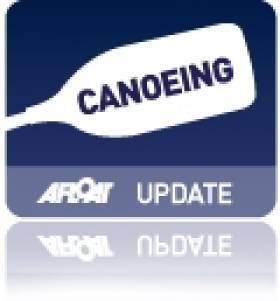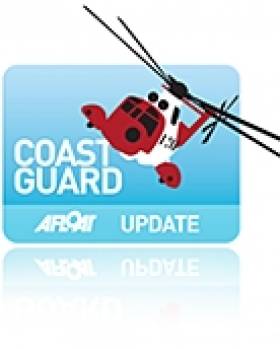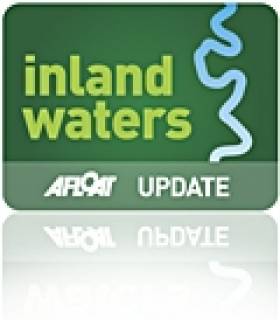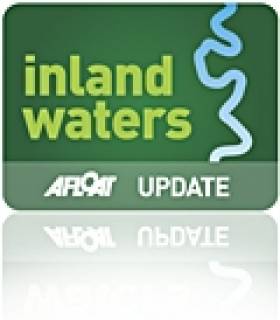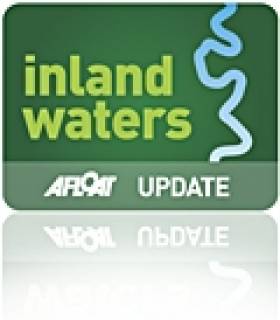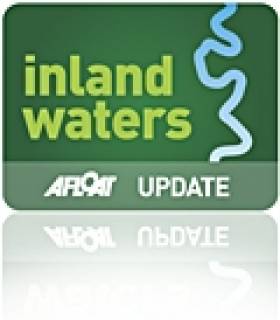Displaying items by tag: Shannon
Minister Experiences Eel Conservation First-Hand
#INLAND WATERS - The European eel population is highly endangered and conservation of this species is a priority for Minister Fergus O’Dowd, who recently visited one of the ESB Trap and Transport sites in Athlone, Co Westmeath.
The minister saw first-hand the silver eel operation that involves the capture of the fish at strategic locations upstream in the Shannon catchment and their subsequent release downstream of Parteen Weir in order to aid their passage and bypass the hydropower generating facility.
Minister O’Dowd assisted the fishermen, Brian and Brendan Connell, in the weighing of the silver eels and loading them into an oxygenated tank for transportation by the ESB to Parteen.
“Eels are protected under EU directive,” said the minister. “I am satisfied that Ireland is addressing its obligations under the directive by ensuring the safe passage of eels past Parteen Weir as they travel onward to the Sargasso Sea to spawn.
"I value highly the work done by ESB on the Trap and Transport initiative and the co-operation with IFI (Inland Fisheries Ireland). I saw at first hand how ESB, as a major commercial State company, continues to take very seriously its responsibilities in this area.”
The National and River Basin District Eel Management Plans specify actions that include closure of eel fisheries and markets, mitigation of adverse effects of hydropower generation facilities, improvement of water quality and bio-security issues.
The overall objective is to increase the biomass of spawning eel leaving Irish waters as the stock has depleted to a dangerous level.
Inland Fisheries Ireland monitors this ESB-sponsored operation throughout its duration, checking weigh and condition of the fish.
Navigation Restrictions in Enniskillen for Hallowe'en Night Fireworks
#INLAND WATERWAYS - Waterways Ireland is advising all masters and users of the Erne navigation that a fireworks display will take place at Castle Island in Enniskillen on Hallowe'en night around 8pm.
Masters of vessels are advised that in there interest of public safety, there will be no mooring permitted at the Waterways Ireland head office mooring nor at the Henry Street public jetties on the day of the event.
Navigation in the vicinity of Castle Island is also prohibited for the duration of the event.
Alternative mooring is available at the Forum and Regal Pass jetties with easy access to event vantage points. Instructions from safety vessels must be adhered to at all times.
Further information may be had from the Lough Erne manager/warden at the Waterways Ireland head office at +44 48 66 322 836.
Meanwhile, Waterways Ireland also reminds masters and users of the Lower Bann and Shannon waterways that the winter schedule for lock and bridge opening times will take effect from this coming Thursday 1 November, running till Sunday 31 March 2013.
Full details of opening times are available on PDF format for both the Lower Bann Navigation and the Shannon Navigation.
Irish Naval Architect Pioneers New Lifeboat 50% Faster than the Rest
#rnli – A young Irishman has played a significant role in developing the RNLI's most advanced class of lifeboat - the Shannon class. Named after the River Shannon and almost 50% faster than the lifeboats it will replace - the Shannon will help the charity's volunteer crews reach those in need even quicker.
Capable of 25 knots, the Shannon is the first modern RNLI all-weather lifeboat to be powered by water jets, not propellers. Over 50 new Shannons will need to be built within the next ten years to replace the older classes of lifeboat and the charity estimates that the 50+ Shannons in their class will rescue over 56,000 people and save the lives of over 1,500 in its lifetime.
Peter Eyre, an RNLI Naval Architect from Derry in Northern Ireland was instrumental in the development of the new lifeboat, designing the hull form at the age of 24 in his spare time. Four years after Peter's original design, the prototype of the Shannon class lifeboat is undergoing sea trials around the coasts of the UK and Ireland, with the first lifeboat going into service in 2013.
Peter Eyre, RNLI Naval Architect says:
'I kept the design under wraps in the early stages. After a while my boss could see I was working on something and encouraged me to continue. My job was to find the design by working with other naval architects, not to design it. I was the youngest in the team and before long I had designed the new lifeboat hull.
'I'm chuffed it was named after an Irish river and the strong connection the boat now has with Ireland. I think the moment it first goes out on a service will be the high point of my career. My parents will be so proud. It's a great legacy to be a part of, especially at this age. I think it will sink in gradually. When the first life is saved I think that's when it will really hit home.'
The Shannon class is expected to make up almost a third of the RNLI's all-weather lifeboat fleet and once rolled out all RNLI all-weather lifeboats will be capable of at least 25 knots. The Shannon class will also improve the safety and welfare of the charity's volunteer crews, thanks to its shock absorbing seats and computer monitoring and operating system.
While Peter was not to become actively involved with the RNLI till later in his life, he had a brush with the charity in 1998 when the Lough Swilly RNLI Lifeboat came to his aid.
Peter explains:
'I was just 14-years-old at the time when my family's 30ft cruiser racer yacht was dismasted in rough seas and force 7 winds. The yacht lost its mast and was escorted back to shore by the volunteer lifeboat crew. We were so relieved'
Owen Medland, RNLI Training Divisional Inspector for Ireland says:
'This is the first time that the RNLI has named a class of lifeboat after an Irish river – which is very fitting considering that Peter has been so fundamental in its design. All of the crews who have tested the new lifeboat have been thrilled with its speed, manoeuvrability and the improved crew safety features. We don't know yet which Irish lifeboat stations will receive a Shannon class lifeboat, but the Shannon is designed to replace the majority of Mersey and some Tyne class lifeboats. We look forward to seeing the Shannon here in the near future.'
The RNLI has launched a €6M fundraising campaign across the UK and Ireland to fund two Shannons and their launch and recovery vehicles designed by Supacat for the relief fleet. These 'relief lifeboats' will be used to replace station boats when they go for maintenance or repair and will therefore operate at many places around the UK and the RoI.
Blind Canoeist to Paddle Length of River Shannon for Charity
#canoe – A blind journalist, canoeist and past pupil at ChildVision's national education centre for blind children will paddle the River Shannon in aid of ChildVision this weekend. Wesley Bourke and his paddling partner Aisa Cooper will take on the 360km (225 mile) feat from August 16th-19th, covering 100km per day for the first three days. The challenge will begin at Dowra in County Cavan and cover the counties of Leitrim, Roscommon, Longford, Offaly, Westmeath, Galway, Clare and Tipperary as they make their way to Limerick.
"No blind person has ever done this before but I'm confident we'll not only complete the challenge, but we'll get it done on schedule," said Bourke. "And ChildVision really deserves every support you can give them, and I hope everyone along the route will be generous in supporting them, and us, too."
Wesley was diagnosed with Leber's hereditary optic neuropathy at a eighteen while he was completing an apprenticeship with the Air Corp, leaving him with less than 15% vision. He attended ChildVision's integrated post-primary school, Pobal Scoil Rosmini, to complete his Leaving Certificate. Graduating in 1998 Wesley went on to study International relations at the University of Hull and Kings College London. He now works as a journalist at An Cosantóir, the Defence Forces magazine.
An adventure enthusiast, Wesley recently completed the Devizes – Westminster International Canoeing Marathon with Aisa, paddling over 200km in a two man kayak in preparation for this event. Wesley and Aisa are members of the Celbridge Paddlers Canoe Club, Co. Kildare.
The pair will take to the Shannon in a K2 kayak on August 16th to raise funds for ChildVision, Ireland's only national education centre for blind children. ChildVision works with over 800 families throughout the country providing educational resources and facilities for blind children.
Shannon Helicopter Goes The Distance for Donegal Rescue
#COASTGUARD - The Shannon-based Irish Coast Guard rescue helicopter was dispatched to the Donegal coast on Friday night to rescue a young boy seriously injured in a farming accident.
As the Clare Herald reports, Rescue 115 - which only entered service a month ago - was called on to make the long-distance journey after the Sligo coastguard chopper was grounded by technical problems.
The mission put Shannon's new Sikorsky S92A craft's long-range capabilities and specialist medical equipment to the test, as it flew from Clare to Tory Island via Sligo General Hospital to evaculate the six-year-old boy, airlifting him to Letterkenny General Hospital for treatment.
As previously reported on Afloat.ie, the Irish Coast Guard took delivery of the new chopper at its Shannon base earlier this year as part of the rescue service's €500 million deal with CHC Ireland to revamp the aircraft fleet. Shannon is the only base to receive a brand new helicopter as part of the contract.
Equipped for dedicated search and rescue operations, the Sikorsky S92A provides coverage for deep Atlantic Ocean missions, services Ireland's offshore islands and provides rescue cover on the west coast from Cork to Galway.
Largest Boat Rally to Arrive in Limerick this Weekend
#inland – The Largest Boat Rally to ever travel to Limerick will arrive at the Hunt Museum this weekend the 30th-1st July as part of an organised tour to Kilrush for boaters from all over the inland waterway system.
Over 80 boats are expected to take part in this momentous event as they depart in groups from 5.30am on Saturday and Sunday morning leaving Killaloe & Ballina and heading to Parteen Weir, Ardnacrusha and down into Limerick City itself.
This rally is extremely special in that many of the boaters have never made the journey through the lock and into Limerick before. This 'newbies' rally where boats travel 'in company' is designed to show inland waterway boaters the joys of travelling through Ardnascrusha and into the city and as they travel under the guidance of highly experienced boaters from the Inland Waterways Association of Ireland (IWAI) , any 'fear of the unknown' is greatly reduced.
Éanna Rowe Head of Marketing & Communications, Waterways Ireland confirmed "Waterways Ireland is delighted that the moorings in Limerick City are ready to receive such a large flotilla, as all the works have been completed over the winter in preparation for more boat traffic through Limerick. That fact that these boaters are mostly new visitors to Limerick is to be greatly welcomed. I hope their experience is highly enjoyable and that they stay longer on their next journey."
Dave Mc Cade and Noel Griffin Organisers of the Rally stated "The IWAI is delighted to be bringing this rally into Limerick, and the Open Day on Sunday 1st July is a great opportunity for local people to come down and visit us on Arthurs Quay and behind the Hunt Museum."
Limerick City Reopens to Boaters After Dredging Works
#shannon – Waterways Ireland has successfully completed dredging maintenance in Limerick City around Sarsfield Lock and the Abbey River undertaken over the Winter & Spring of 2011/12 so the city is once again open to boating traffic.
This contract was challenging due to the requirement to execute the works during the winter, out of the boating season. The Abbey River experienced very high flows at this time of year as a result of operations at Ardnacrusha Power Station and part of works were undertaken in a tidal zone of the river. Meticulous planning by Waterways Ireland and the contractor was required to ensure the dredging was carried out safely and effectively in reduced daylight hours, under strict environmental guidelines with severely limited access and traffic restrictions within the city. The contract resulted in the removal of approximately 20,000 tonnes of sediment deposits from the navigation channel in the Abbey and Shannon Rivers.
The work programme was carefully planned approximately 18 months in advance and involved extensive consultation with National Parks and Wildlife Service, Shannon Foynes Port Company, Inland Fisheries Ireland & Limerick City Council (Planning, Roads, Environment and Waste sections) to minimise the impact of the essential maintenance works on the sensitive habitats that have become established within the Shannon estuary.
Licences to undertake the work were secured in October 2011 and continual monitoring ensured that the works were carried out in full compliance with current environmental legislation. In addition the consultations developed into regular communications during the progress of the contract and also involved the local rowing clubs and city councillors.
The contract was undertaken in three phases as a result of differing site requirements and conditions. The first phase from the Custom House Quay to Sarsfield Lock was undertaken in October 2011 and required the employment of a pontoon mounted excavator with barges. Barges transported the material to Sarsfield Lock where a temporary loading area was constructed for load out to lorry.
The second phase of the contract was undertaken in December and involved the removal of material from the Baals Bridge area of the navigation. Flow conditions in the river dictated the employment an innovative amphibious excavator. Access for this excavator was achieved through the Park Canal and the existing Lock, where it was able to operate directly in the river at low tide conditions. Removal of the material was via an agreed temporary loading area at Baals Bridge
The third phase of the contract, undertaken in February involved the removal of material from the Georges Quay area of the navigation. Work in this area was undertaken last as additional environmental studies and approval was required to protect the Lamprey Eel. Flow conditions in the river dictated a different removal method that employed a smaller pontoon-mounted excavator with an anchorage system. Removal of the material was via an agreed temporary loading area at Georges Quay, immediately adjacent to the Barrington Hospital, direct to lorry and disposal.
All dredged material removed from the Abbey River was transported to a licenced disposal facility in accordance with current disposal legislation and the Traffic Management Plan agreed with Limerick City Council, which was designed to minimise traffic disruption in the city centre.
It is anticipated that this maintenance work will greatly enhance the key asset that the navigation provides to Limerick City and help stimulate greater use of the marina by boats. The improved mooring facilities will also enable the boating enthusiast to access the extensive public amenities available in the city centre, including many restaurants, bars, shops and museums amongst other attractions.
Gandelow Races Return to Limerick City
#GANDELOW – Traditional Gandelow rowing races will be held on the river Shannon in Limerick City on Saturday, May 19th 2012. The day will begin with a reception and presentation of boats, followed by public talks and racing.
The event is a celebration of historic Limerick City and Shannon estuary river ways. It also celebrates the building of five Gandelows, river boats which were once an integral part of the economic life of the City. Though naval in style, Gandelows continue to contribute richly to the architectural mix that makes up the built City.
It is also a celebration of the work of the ILEN Wooden Boat Building School who, in collaboration with river folk and community groups, have come together to build five boats and stage a cultural and educational river event.
The programme is as follows:
Morning Programme, Venue Strand Hotel:
10.30am – Reception and presentation of Limerick city's new fleet of Gandelows
11.00am – Public Lectures in the City & Harris Suite, Strand Hotel
11.15am – Lecture by Anthony Keane OSB – 'They sailed to the sea in ships',
Anthony Keane is a Benedictine Monk & Forester. He has been a monk of Glenstal Abbey for more than thirty years and is also a founding director of the AK Ilen Company as well as a Gandelow Races organiser.
12.00pm – Lecture by Lance Lee USA – Wooden Boatbuilding & Community Education
Lance Lee, founder of several incarnations of The Apprenticeshop Maine USA, of Atlantic Challenge International, and of the Tremolino! Project, has worked on numerous boatbuilding projects with hundreds of students and boatbuilders – all over the world.
His journey in wooden boatbuilding education began in 1968 and when many men would be winding down, Lance Lee continues to embrace new challenges. One of his recent projects, was working with boatbuilder Brady Gow to build a smaller version ofTremolino, the lateen-rigged balancelle (a Mediterranean workboat) used by Joseph Conrad to run guns for the royalist cause between Marseilles and Catalonia in the late 1800s. This should prove to be a most stimulating and inspiring lecture.
1.00pm – Lunch break
Afternoon Programme, Racing between Sarsfiled Bridge and Shannon Bridge
2.30pm – Launch of boats
3.00pm – First of three races commences
4.30pm – Prize giving and closing address
For more information please call Mobile 086 2640479 or email: [email protected]
Titanic Emergency as Ill Passenger Airlifted
#TITANIC - The Titanic memorial cruise was yesterday forced to turn back just 100 miles from the southwest coast of Ireland after a passenger fell ill, BBC News reports.
The Irish Coast Guard rescue helicopter at Shannon was dispached to the MS Balmoral to retrieve BBC cameraman Tim Rex, 56, who was struck by a non-life threatening heart condition, according to the Irish Independent.
Rex, who was covering the memorial sailing for the BBC, was treated by ship's doctors before being airlifted to hospital as a precaution.
The emergency happened just hours after the ship departed Cobh, the last port of call of the ill-fated Titanic before it sank in the North Atlantic on 14 April 1912.
A spokesperson for Titanic Memorial Cruises confirmed that despite the delay, the ship is still on schedule and is expected to arrive at the Titanic wreck site as planned on Saturday.
Shannon Navigation Winter Mooring Period Ends
#INLAND – The Winter Mooring period in Public Harbours on the Shannon Navigation and the Shannon –Erne Waterway has ends onSat 31 Mar 2012. Thereafter the Navigation Bye-law No. 17(3) applies and vessels should not berth in the same harbour for longer than the statutory period of five consecutive days nor more than a total of seven days in any one month. The full notice from Waterways Ireland is downloadable below.


























